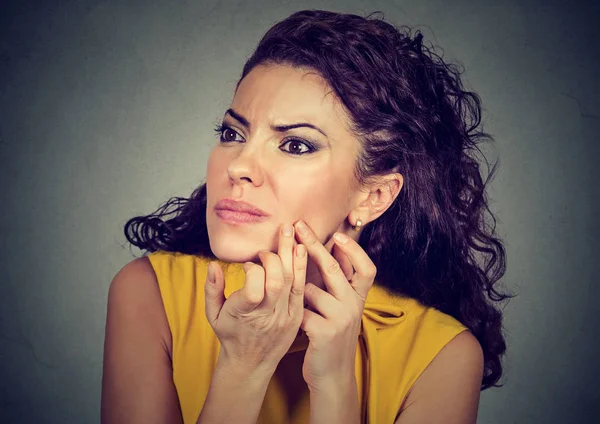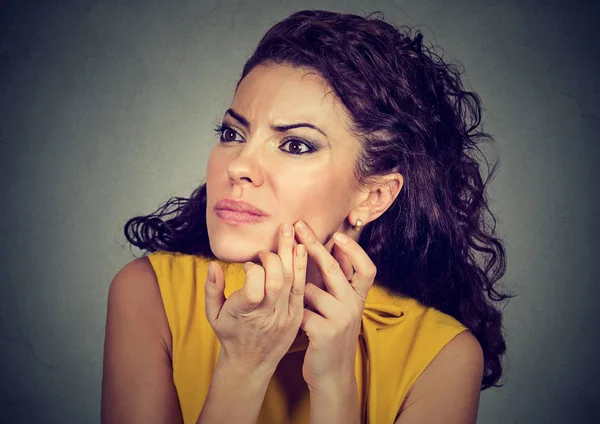Navigating the complexities of Hormonal Acne in Women can be an overwhelming journey. Many find it challenging to tackle the issue alone, given its manifestation as deep, cystic pimples that typically emerge around the chin, jawline, and facial areas.
These troublesome breakouts are often the result of hormonal imbalances — specifically, fluctuations in reproductive and stress-related hormones that trigger excess sebum (oil) production within the skin’s pores. It’s not uncommon for those affected to experience their most severe outbreaks in sync with certain phases of their menstrual cycle, potentially leading to lasting scars if not addressed.

Understanding the root cause of your acne is crucial in combating it effectively. This requires a deeper exploration into what might be causing the hormonal imbalances fueling your skin’s condition, a topic we’ve extensively covered in previous discussions. For those just beginning their journey to comprehend and manage their hormonal acne, ample resources are available to guide your initial steps.
For individuals who are in the process of examining their hormonal health or have embarked on treatment, being aware of potential triggers that could exacerbate your condition is beneficial. Identifying and avoiding these triggers can significantly aid in your skin’s healing process.
What is Hormonal Acne and Why Does it Affect Women?
Hormonal acne, also known as adult acne, differs from the typical teenage breakouts. It primarily affects women aged 25-40 and is triggered by fluctuations in hormones, particularly androgens. These androgens, including testosterone, stimulate the sebaceous glands to produce more sebum, an oily substance that lubricates and protects your skin. However, excess sebum can clog pores, trap dead skin cells, and create the perfect environment for bacteria to thrive, leading to inflammation and breakouts, particularly on the lower face (jawline, chin, and cheeks).
Statistics reveal that:
- Up to 26% of women aged 25-40 experience hormonal acne [1].
- Androgen levels fluctuate naturally throughout your menstrual cycle, often leading to breakouts around your period.
- Conditions like Polycystic Ovary Syndrome (PCOS), which affects hormone balance, can also contribute to hormonal acne.
5 Triggers for Hormonal Acne in Women: Recognizing the Culprits
Being aware of the potential triggers for your acne can help you manage them effectively. Here are five key factors to consider:
- Fluctuating Testosterone Levels: As mentioned earlier, testosterone fluctuations throughout your menstrual cycle can lead to breakouts. Additionally, conditions like PCOS can elevate testosterone levels, contributing to acne development.
- Stress: Ever feel like your skin reflects your stress levels? You’re not wrong! Chronic stress can trigger the release of cortisol, a hormone that can disrupt the delicate balance of other hormones, including androgens, and exacerbate acne.
- Diet: While the exact link between diet and acne is still being researched, studies suggest that foods with a high glycemic index (GI), which causes rapid spikes in blood sugar, may worsen breakouts. Additionally, dairy consumption has been linked to hormonal acne in some individuals.
- Exercise: Exercise is fantastic for your overall health, but intense workouts can trigger breakouts due to increased sweat production and potential clogging of pores. However, this doesn’t mean you have to ditch the gym! I’ll share some helpful strategies to mitigate this later.
- Medications: Certain medications, including birth control pills, can impact hormone levels and potentially trigger acne in some individuals. It’s crucial to discuss this with your healthcare provider if you suspect a link.
Strategies for Reducing Hormonal Acne: Taking Control of Your Skin
Now that you understand the potential triggers, let’s explore practical strategies to combat hormonal acne and achieve clear, beautiful skin:
Consider Your Diet:
- Embrace a balanced diet: Focus on whole, unprocessed foods rich in fiber, protein, healthy fats, and antioxidants. These foods provide essential nutrients for healthy skin function and may help reduce inflammation.
- Limit sugar and processed foods: Studies suggest that high-glycemic index (GI) foods can contribute to hormonal imbalances and worsen acne. Opt for complex carbohydrates like whole grains, fruits, and vegetables instead.
- Explore the potential role of dairy: While dairy doesn’t affect everyone, some individuals find that reducing or eliminating dairy from their diet leads to a significant improvement in their acne. It’s worth experimenting to see if this makes a difference for you.
- Consult a healthcare professional: They can provide personalized dietary recommendations based on your individual needs and health history.
Meal Plan for Hormonal Acne Management
| Meal | Example |
| Breakfast | Greek yogurt with berries, chia seeds, and a sprinkle of almonds |
| Lunch | Grilled chicken salad with mixed greens, quinoa, avocado, and olive oil dressing |
| Dinner | Salmon with roasted vegetables and brown rice |
| Snack | Apple slices with almond butter or carrot sticks with hummus |
Reduce Stress:
- Mindfulness practices: Techniques like meditation, yoga, or deep breathing can help manage stress and potentially reduce cortisol levels, leading to improved skin health.
- Prioritize sleep: Aim for 7-8 hours of quality sleep each night. Adequate sleep allows your body to repair and rejuvenate itself, which can benefit your skin health.
- Engage in activities you enjoy: Make time for hobbies and activities that bring you joy and help you de-stress.
Don’t Overdo the Exercise:
- Maintain an active lifestyle: Exercise is crucial for overall health, but it’s essential to find the right balance for your skin. Listen to your body and avoid overly strenuous workouts that lead to excessive sweating and potential pore clogging. Opt for moderate-intensity exercises like brisk walking, swimming, or yoga, and shower immediately after your workout to remove sweat and prevent clogged pores.
- Cleanse your face thoroughly after sweating: Use a gentle, non-comedogenic cleanser to remove sweat, dirt, and oil from your skin.
- Enjoy regular exercise, but listen to your body and avoid overexertion, which can lead to increased sweat production and potential breakouts.
- Shower or cleanse your face immediately after sweating: This helps remove sweat, dirt, and oil that can clog pores.
- Use non-comedogenic skincare products: These products are formulated not to clog pores, further preventing breakouts.
Remove Any Makeup Before Bed: Allow Your Skin to Breathe
Imagine your skin as a beautiful garden. During the day, it encounters various elements like dust, pollutants, and makeup. While makeup can enhance your features, leaving it on overnight can be detrimental to your skin’s health, particularly if you struggle with hormonal acne. Here’s why removing makeup before bed is crucial:
1. Clogged Pores and Breakouts: Throughout the day, your skin naturally produces oil (sebum) to keep it hydrated and protected. Makeup, especially those with comedogenic (pore-clogging) ingredients, can create a barrier on your skin, trapping sebum, oil, and dead skin cells within the pores. This creates the perfect environment for bacteria to thrive, leading to inflammation and breakouts.
2. Impaired Skin Cell Turnover: During the night, your skin goes into repair mode, working hard to shed dead skin cells and regenerate new ones. This process is vital for maintaining a healthy and radiant complexion. However, leaving makeup on overnight can hinder this natural renewal process, leading to dullness, uneven skin tone, and potentially even worsening existing breakouts.
3. Irritation and Sensitivity: Even the most gentle makeup formulas can irritate sensitive skin, especially when left on for extended periods. Leaving makeup on overnight can exacerbate this sensitivity, causing redness, dryness, and discomfort.
4. Accelerated Signs of Aging: Think of sleep as your skin’s “beauty rest.” While you slumber, your skin is actively repairing itself and fighting free radical damage. Leaving makeup on overnight can hinder this process and potentially contribute to premature signs of aging, such as fine lines and wrinkles.
Here’s how to ensure your skin gets the nightly breathing it deserves:
- Develop a gentle nighttime cleansing routine: Regardless of your skin type, find a gentle cleanser suitable for your needs. Look for cleansers that are fragrance-free and non-comedogenic to avoid irritation and clogged pores.
- Double cleanse if needed: If you wear heavy makeup or sunscreen, consider double cleansing. Use an oil-based cleanser to remove makeup and sunscreen, followed by a water-based cleanser to remove any remaining residue and impurities.
- Be gentle: Avoid harsh scrubbing or rubbing your skin, as this can irritate it further. Use gentle circular motions and lukewarm water to remove makeup effectively.
- Pat your skin dry: Once you’ve cleansed thoroughly, avoid rubbing your face with a towel. Instead, pat your skin dry with a soft, clean towel.
- Follow up with a moisturizer: Apply a lightweight, oil-free moisturizer suitable for your skin type to keep your skin hydrated throughout the night.
By incorporating these steps into your nightly routine, you can give your skin the chance to breathe, repair, and regenerate, paving the way for a clearer, healthier, and more radiant complexion. Remember, consistency is key! Make removing your makeup before bed a non-negotiable part of your self-care routine, and experience the confidence and joy of waking up to refreshed, beautiful skin.
Use the Right Products:
- Choose non-comedogenic skincare: Look for products labeled “non-comedogenic” or “oil-free” to minimize the risk of clogged pores.
- Gentle cleansers: Avoid harsh scrubs or drying products that can irritate your skin and worsen breakouts. Opt for gentle cleansers that remove impurities without stripping your skin of its natural oils.
- Moisturize: Contrary to popular belief, even oily skin needs hydration. Choose a lightweight, oil-free moisturizer to keep your skin hydrated and prevent it from overproducing oil.
- Consult a dermatologist: They can recommend specific skincare products tailored to your individual needs and acne severity.
Test Your Hormones (if needed):
Consult your healthcare provider: If you suspect an underlying hormonal imbalance might be contributing to your acne, they can recommend blood tests to assess your hormone levels.
- Blood testing: Blood testing can reveal a lot about what is happening to your hormones, but it’s important that you know where you are in your menstrual cycle when you do the testing because hormones fluctuate throughout your cycle.
- Androgens: Blood testing can reveal high androgens such as androstenedione, testosterone and free testosterone.
- Luteinizing hormone (LH) & Follicle stimulating hormone (FSH): These are important hormones to test at the start of your cycle because their ratio to one another can reveal an underlying issue.
- Fasting insulin and glucose: As you will now be aware, blood sugar levels and insulin resistance can cause big problems for your hormones if they are out of range. Checking these first thing in the morning, and fasting on an empty stomach are key to understanding if they are playing a part.
- Saliva hormone testing: Saliva hormone testing is a lot easier to utilise, and it looks at the context of your hormones in the luteal phase of your cycle (after ovulation). The beauty of this testing is that it also checks your adrenal hormones to understand the extent to which stress plays a part.
- Saliva testing checks testosterone, estrogen, and progesterone at a time in your cycle when estrogen and progesterone should be dominant. Looking at the hormone levels at this time of the menstrual cycle helps us to decipher if it’s low female hormones or high testosterone causing your breakouts.
- Treatment options: Depending on the identified hormonal imbalances, your doctor might recommend specific medications or therapies to regulate your hormones and improve your skin health.
Beyond the Basics: Additional Tips for Managing Hormonal Acne
- Drink plenty of water: Aim for eight glasses of water daily to keep your skin hydrated and promote overall well-being.
- Change your pillowcase regularly: This helps prevent the buildup of bacteria and dead skin cells on your skin, which can contribute to breakouts.
- Avoid touching your face: This can transfer dirt and oil to your skin, increasing the risk of breakouts.
- Be patient and consistent: It takes time to see results from any new skincare routine or treatment plan. Be patient, consistent with your efforts, and track your progress to identify what works best for you.
Remember, you are not alone in this journey! If you’re struggling with hormonal acne, reach out to a healthcare professional or a qualified naturopath for personalized guidance and support. With the right approach and a combination of lifestyle changes, dietary modifications, and potentially professional treatment, you can achieve clear, healthy skin and regain your confidence.
Don’t Miss | Jawline Acne Treatment: Causes, Cures, and Prevention








